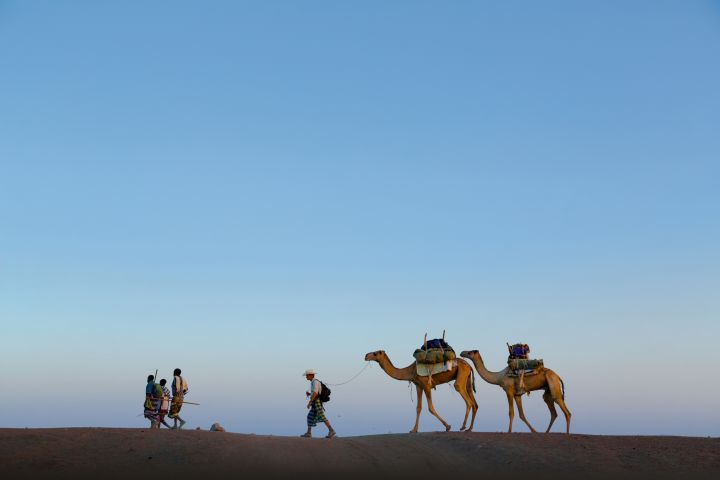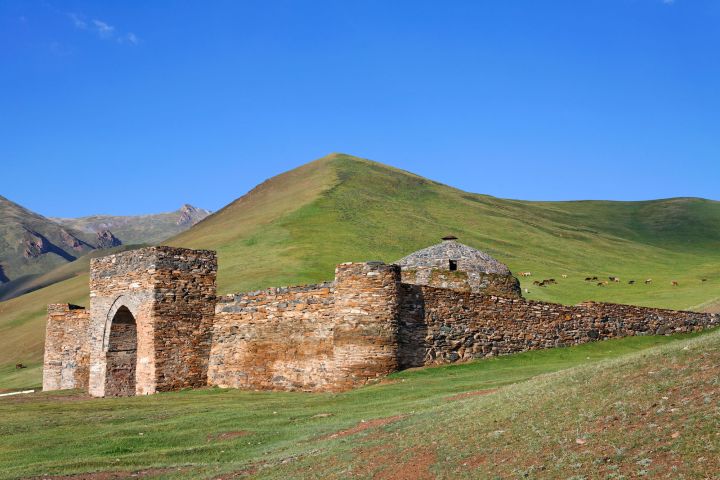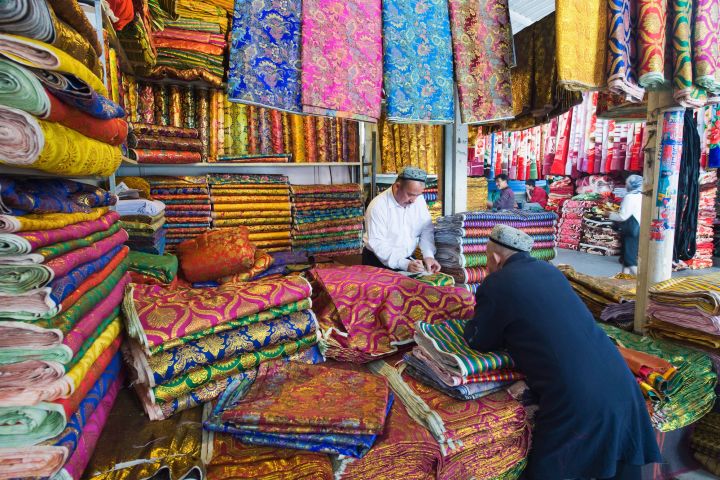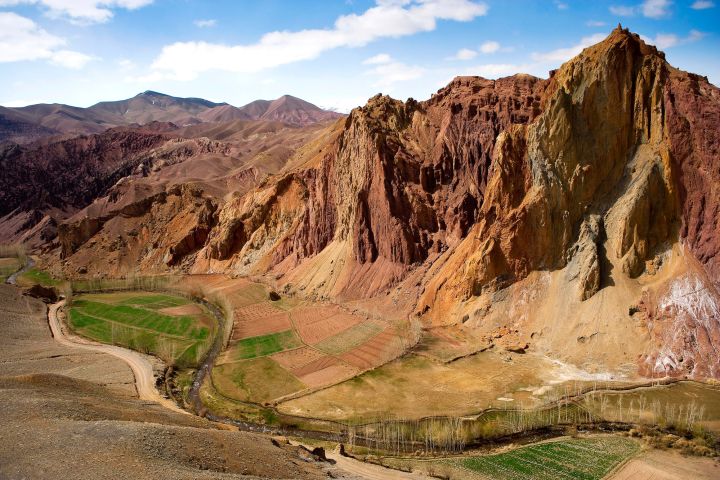IDEA SET
IDEA SET
Connecting the Globe Along the Silk Road
Connecting the Globe Along the Silk Road
The Silk Road has connected far-flung peoples and civilizations throughout the world for hundreds of years. Some of those ancient pathways are getting a modern makeover.
Grades
7 - 9
Subjects
Arts and Music, Geography

Photograph by Mekdet
Use these five ideas to engage learners in the history of the Silk Road. Each idea highlights an important facet of this set of ancient trade routes while encouraging students to make geographic, present-day connections to the region. These ideas include China's New Silk Road development strategy, war-torn Afghanistan, and National Geographic Fellow Paul Salopek's 34,000-kilometer (21,000-mile) Out of Eden walk.

National Geographic Fellow Paul Salopek on the Silk Road
National Geographic Fellow Paul Salopek is traveling the globe on foot, covering 34,000 kilometers (21,000 miles) from Ethiopia in Africa to Patagonia in South America as he retraces the migration paths of our ancient ancestors. Have students navigate to Chapter Four of the Out of Eden Walk blog. Provide them with an overview of the Silk Road section of Paul’s journey using the map to the right of the screen. Open Google Earth in a separate browser. As you scroll through the images of Paul’s Silk Road journey together, first have students search and fly to the location in question on Google Earth, then ask students to look back at the blog to make observations about the types of landscapes Paul passes through in Central Asia. Discuss the geography of the “Stans” through which he walks: steppe, grassland, arid desert, and mountains. In groups, have students brainstorm what some of the difficulties of traveling through this landscape by horse or camel caravans would have been (exposure to bad weather; vulnerability to bandits; or scarcity of water, food sources, or forage for animals). Have students read Paul’s post from the Ustyurt Plateau in Western Kazakhstan: “To Walk this Wilderness, Carry a Shovel.” Use the reading to answer this guiding question: “Why would a shovel be so important when traveling the Silk Road in Western Kazakhstan?” If time permits, have the students briefly journal about whether they would have wanted to travel through such a challenging environment as part of a caravan for the sake of making a profit. Why or why not?

Fortress? Or Hotel?
Have students utilize Google Earth Street View to view images of Tash Rabat (40°50'05.25" N 75°17'36.35" E), a well-preserved fifteenth century caravanserai in Kyrgyzstan. Encourage students to speculate on the purpose of the structure. Reveal that it was, in fact, a “hotel” of sorts for travelers on the Silk Road. Explain that caravanserais were hotel-fortress hybrids that sprang up along trade routes through Silk Road countries. Have students use the internet to search for other examples of surviving caravanserais or imagined reconstructions of existing ruins, then elaborate on the distinguishing features of caravanserais. Next, in pairs or small groups, students should compare and contrast caravanserais to hotels, inns, or bed-and-breakfast establishments they have seen or stayed in. How was the purpose of the caravanserai the same? Different? Encourage students to speculate: “How might the caravanserais have contributed to the spread of not just material goods, but ideas and cultures as well?” As an extension, have students read Paul Salopek’s blog post from Out of Eden Walk titled “Relic Walls of the Ancient Silk Road.” Questions to consider: What were some of the positives outcomes of the globalization encouraged by the Silk Road and the caravanserais? The negative outcomes? Did the positives outweigh the negatives?

What's in a Name?
How did the Silk Road get its name? Prompt students to speculate and talk about the unique nature and value of silk. Silk was one of the more expensive and popular items traded along the Silk Road: thus, the name “Silk Road.” But was it really the MOST important item exchanged on those trade routes? Have students read all or part of the Ancient History Encyclopedia article on the Silk Road and discuss the other goods that were moved along the routes from East to West and from West to East. Encourage students to debate which of these trade goods was most important, defending their choices. Segue to the Silk Road as a vehicle for the spread of ideas and culture by reading or re-reading the last section of the Ancient History Encyclopedia article. Introduce the concept of “cultural diffusion,” a term used in sociology to describe the spread of ideas and customs from one culture to another. What ideas and customs were exchanged via the Silk Road? (Examples: Technologies such as glass and paper making, religious ideas and beliefs, or words and language—for example, roughly 35,000 new words entered Chinese from Buddhist missionaries). In light of the lesson’s activities, ask students to create a new name for the Silk Road that highlights the most important trade good(s) and the cultural diffusion brought about by the trade routes.

Afghanistan and the Silk Road
Begin class by asking students to share what they know about Afghanistan, focusing specifically on the country’s climate and geography. Then have students fly to Afghanistan on Google Earth to orient them geographically. Show Khyber Khan’s short aerial film, The Unseen Afghanistan. Ask students to pay attention to the country’s topography as they view the film. Have students consider how the topography would influence trading by asking: On a scale of one to 10, how difficult do they think it would have been for a caravan of Silk Road traders to pass through this country? Why? Then distribute copies of Silk Road Threads through History to determine why Afghanistan was important for Silk Road trade despite the difficult terrain. Have students explore Dr. Hiebert’s photos from the Afghanistan: Hidden Treasures from the National Museum, Kabul exhibit to identify evidence of historical cultural exchange between Afghanistan and other locations along the Silk Road (including a water spout designed like a Greek theatrical mask and shoe buckles probably originating from Mongolia or China) Though the Silk Road no longer exists in the same form, Afghanistan still provides important goods to neighboring countries. Have students use the Silk Road Threads through History to determine what is considered to be the new “silk” in the modern age, according to Dr. Hiebert. Then have student consider whether trade of this new “silk” (gas and oil) brings about the same cultural exchange. Why or why not?

Silk Road Redux
Have students view an image of the world at night using Google Earth. Discuss the darker areas of the map and what the presence or absence of artificial light tells us about certain areas on Earth. Draw students’ attention to the areas of the map that will be traversed by China’s New Silk Road project. Introduce students to China’s “Belt and Road” initiative by having them view two short videos on the topic, a Chinese government promotional video (CGTN’s What is the One Belt One Road Initiative?) and a news segment from a Turkish news network (TRT’s Silk Road Summit: What is China’s New Silk Road project?). Encourage students to evaluate China’s project using these guiding questions: What are some potential advantages, for China and other nations, of this project? What are some potential disadvantages or concerns? How would the New Silk Road be like the old one? How would it be different? Will China’s new project benefit or harm global trade? How?
Media Credits
The audio, illustrations, photos, and videos are credited beneath the media asset, except for promotional images, which generally link to another page that contains the media credit. The Rights Holder for media is the person or group credited.
Director
Author
Production Managers
Program Specialists
Producer
Intern
other
Last Updated
January 24, 2024
For information on user permissions, please read our Terms of Service. If you have questions about how to cite anything on our website in your project or classroom presentation, please contact your teacher. They will best know the preferred format. When you reach out to them, you will need the page title, URL, and the date you accessed the resource.
Media
If a media asset is downloadable, a download button appears in the corner of the media viewer. If no button appears, you cannot download or save the media.
Text
Text on this page is printable and can be used according to our Terms of Service.
Interactives
Any interactives on this page can only be played while you are visiting our website. You cannot download interactives.